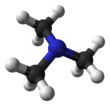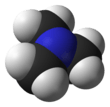Trimethylamine
Trimethylamine (TMA) is an organic compound with the formula N(CH3)3. It is a colorless, hygroscopic, and flammable tertiary amine. It is a gas at room temperature but is usually sold as a 40% solution in water. (It is also sold in pressurized gas cylinders.) TMA is a nitrogenous base and can be readily protonated to give trimethylammonium cation. Trimethylammonium chloride is a hygroscopic colorless solid prepared from hydrochloric acid. Trimethylamine is a good nucleophile, and this reaction is the basis of most of its applications. TMA is widely used in industry: it is used in the synthesis of choline, tetramethylammonium hydroxide, plant growth regulators or herbicides, strongly basic anion exchange resins, dye leveling agents, and a number of basic dyes.[5][6] At higher concentrations it has an ammonia-like odor, and can cause necrosis of mucous membranes on contact.[7] At lower concentrations, it has a "fishy" odor, the odor associated with rotting fish.
 | |||
| |||
| Names | |||
|---|---|---|---|
| Preferred IUPAC name
N,N-Dimethylmethanamine | |||
| Other names
(Trimethyl)amine (The name trimethylamine is deprecated.)[2] | |||
| Identifiers | |||
3D model (JSmol) |
|||
| 3DMet | |||
| 956566 | |||
| ChEBI | |||
| ChEMBL | |||
| ChemSpider | |||
| ECHA InfoCard | 100.000.796 | ||
| EC Number |
| ||
| KEGG | |||
PubChem CID |
|||
| RTECS number |
| ||
| UNII | |||
| UN number | 1083 | ||
CompTox Dashboard (EPA) |
|||
| |||
| |||
| Properties | |||
| C3H9N | |||
| Molar mass | 59.112 g·mol−1 | ||
| Appearance | Colorless gas | ||
| Odor | Fishy, ammoniacal | ||
| Density | 670 kg m−3 (at 0 °C) 627.0 kg m−3 (at 25 °C) | ||
| Melting point | −117.20 °C; −178.96 °F; 155.95 K | ||
| Boiling point | 3 to 7 °C; 37 to 44 °F; 276 to 280 K | ||
| Miscible | |||
| log P | 0.119 | ||
| Vapor pressure | 188.7 kPa (at 20 °C)[3] | ||
Henry's law constant (kH) |
95 μmol Pa−1 kg−1 | ||
| Basicity (pKb) | 4.19 | ||
| 0.612 D | |||
| Thermochemistry | |||
Std enthalpy of formation (ΔfH⦵298) |
−24.5 to −23.0 kJ mol−1 | ||
| Hazards | |||
| GHS pictograms |    | ||
| GHS Signal word | Danger | ||
GHS hazard statements |
H220, H315, H318, H332, H335 | ||
| P210, P261, P280, P305+351+338 | |||
| NFPA 704 (fire diamond) | |||
| Flash point | −7 °C (19 °F; 266 K) | ||
| 190 °C (374 °F; 463 K) | |||
| Explosive limits | 2–11.6% | ||
| Lethal dose or concentration (LD, LC): | |||
LD50 (median dose) |
500 mg kg−1 (oral, rat) | ||
| NIOSH (US health exposure limits): | |||
PEL (Permissible) |
none[4] | ||
REL (Recommended) |
TWA 10 ppm (24 mg/m3) ST 15 ppm (36 mg/m3)[4] | ||
IDLH (Immediate danger) |
N.D.[4] | ||
| Related compounds | |||
Related amines |
|||
Related compounds |
|||
Except where otherwise noted, data are given for materials in their standard state (at 25 °C [77 °F], 100 kPa). | |||
| Infobox references | |||
In humans, ingestion of certain plant and animal (e.g., red meat, egg yolk) food containing lecithin, choline and L-carnitine provides certain gut microbiota with the substrate to synthesize TMA, which is then absorbed into the bloodstream.[8][9] High levels of trimethylamine in the body are associated with the development of trimethylaminuria, or fish odor syndrome, caused by a genetic defect in the enzyme which degrades TMA; or by taking large doses of supplements containing choline or L-carnitine.[8][9] TMA is metabolized by the liver to trimethylamine N-oxide (TMAO); TMAO is being investigated as a possible proatherogenic substance which may accelerate atherosclerosis in those eating foods with a high content of TMA precursors.[9] TMA also causes the odor of some human infections, bad breath, and bacterial vaginosis.
In 2013, trimethylamine was identified as a potent full agonist of human TAAR5,[10][11][12] a trace amine-associated receptor that is expressed in the olfactory epithelium and functions as an olfactory receptor for tertiary amines.[12][13] One or more additional odorant receptors appear to be involved in trimethylamine olfaction in humans as well.[13]
Production
Trimethylamine is prepared by the reaction of ammonia and methanol employing a catalyst:[5]
- 3 CH3OH + NH3 → (CH3)3N + 3 H2O
This reaction coproduces the other methylamines, dimethylamine (CH3)2NH and methylamine CH3NH2.
Trimethylamine has also been prepared by a reaction of ammonium chloride and paraformaldehyde,[14] according to the following equation:
- 9 (CH2=O)n + 2n NH4Cl → 2n (CH3)3N•HCl + 3n H2O + 3n CO2↑
Toxicity
Acute and chronic toxic effects of TMA were suggested in medical literature as early as the 19th century. TMA causes eye and skin irritation, and it is suggested to be a uremic toxin.[15] In patients, trimethylamine caused stomach ache, vomiting, diarrhoea, lacrimation, greying of the skin and agitation.[16] Apart from that, reproductive/developmental toxicity has been reported.[7]
Due to toxicity and widespread use of TMA in industry, several guidelines with exposure limit for workers are available e.g. the Recommendation from the Scientific Committee on Occupational Exposure Limits by the European Union Commission.[17]
Recently some experimental studies suggested that TMA may be involved in etiology of cardiovascular diseases.[18][19]
Applications
Trimethylamine is used in the synthesis of choline, tetramethylammonium hydroxide, plant growth regulators or herbicides, strongly basic anion exchange resins, dye leveling agents and a number of basic dyes.[5][20] Gas sensors to test for fish freshness detect trimethylamine.
Trimethylaminuria
Trimethylaminuria is an autosomal recessive genetic disorder involving a defect in the function or expression of flavin-containing monooxygenase 3 (FMO3) which results in poor trimethylamine metabolism. Individuals with trimethylaminuria develop a characteristic fish odor—the smell of trimethylamine—in their sweat, urine, and breath after the consumption of choline-rich foods. A condition similar to trimethylaminuria has also been observed in a certain breed of Rhode Island Red chicken that produces eggs with a fishy smell, especially after eating food containing a high proportion of rapeseed.[21][22]
See also
- Ammonia, NH3
- Ammonium, NH4+
- Methylamine, (CH3)NH2
- Triethylamine (TEA)
References
- Merck Index, 11th Edition, 9625.
- IUPAC Chemical Nomenclature and Structure Representation Division (2013). "P-62.2.2.1". In Favre, Henri A.; Powell, Warren H. (eds.). Nomenclature of Organic Chemistry: IUPAC Recommendations and Preferred Names 2013. IUPAC–RSC. ISBN 978-0-85404-182-4.
- Swift, Elijah; Hochanadel, Helen Phillips (May 1945). "The Vapor Pressure of Trimethylamine from 0 to 40°". Journal of the American Chemical Society. 67 (5): 880–881. doi:10.1021/ja01221a508.
- NIOSH Pocket Guide to Chemical Hazards. "#0636". National Institute for Occupational Safety and Health (NIOSH).
- A. B. van Gysel, W. Musin "Methylamines" in Ullmann's Encyclopedia of Industrial Chemistry, Wiley-VCH Verlag GmbH & Co. KGaA, Weinheim. doi:10.1002/14356007.a16_535
- Ashford's Dictionary of Industrial Chemicals (3rd ed.). 2011. p. 9362. ISBN 978-0-9522674-3-0.
- "Trimethylamine [MAK Value Documentation, 1983]", The MAK-Collection for Occupational Health and Safety, Wiley-VCH Verlag GmbH & Co. KGaA, 27 October 2014, pp. 1–9, doi:10.1002/3527600418.mb7550e0914, ISBN 978-3527600410
- Falony G, Vieira-Silva S, Raes J (2015). "Microbiology Meets Big Data: The Case of Gut Microbiota-Derived Trimethylamine". Annu. Rev. Microbiol. 69: 305–321. doi:10.1146/annurev-micro-091014-104422. PMID 26274026.
we review literature on trimethylamine (TMA), a microbiota-generated metabolite linked to atherosclerosis development.
- Gaci N, Borrel G, Tottey W, O'Toole PW, Brugère JF (November 2014). "Archaea and the human gut: new beginning of an old story". World J. Gastroenterol. 20 (43): 16062–16078. doi:10.3748/wjg.v20.i43.16062. PMC 4239492. PMID 25473158.
Trimethylamine is exclusively a microbiota-derived product of nutrients (lecithin, choline, TMAO, L-carnitine) from normal diet, from which seems originate two diseases, trimethylaminuria (or Fish-Odor Syndrome) and cardiovascular disease through the proatherogenic property of its oxidized liver-derived form.
- Wallrabenstein I, Kuklan J, Weber L, Zborala S, Werner M, Altmüller J, Becker C, Schmidt A, Hatt H, Hummel T, Gisselmann G (2013). "Human trace amine-associated receptor TAAR5 can be activated by trimethylamine". PLOS ONE. 8 (2): e54950. Bibcode:2013PLoSO...854950W. doi:10.1371/journal.pone.0054950. PMC 3564852. PMID 23393561.
- Zhang J, Pacifico R, Cawley D, Feinstein P, Bozza T (February 2013). "Ultrasensitive detection of amines by a trace amine-associated receptor". J. Neurosci. 33 (7): 3228–39. doi:10.1523/JNEUROSCI.4299-12.2013. PMC 3711460. PMID 23407976.
We show that [human TAAR5] responds to the tertiary amine N,N-dimethylethylamine and to a lesser extent to trimethylamine, a structurally related agonist for mouse and rat TAAR5 (Liberles and Buck, 2006; Staubert et al., 2010; Ferrero et al., 2012).
- Zhang LS, Davies SS (April 2016). "Microbial metabolism of dietary components to bioactive metabolites: opportunities for new therapeutic interventions". Genome Med. 8 (1): 46. doi:10.1186/s13073-016-0296-x. PMC 4840492. PMID 27102537.
Table 2: Microbial metabolites: their synthesis, mechanisms of action, and effects on health and disease
Figure 1: Molecular mechanisms of action of indole and its metabolites on host physiology and disease - Liberles SD (October 2015). "Trace amine-associated receptors: ligands, neural circuits, and behaviors". Curr. Opin. Neurobiol. 34: 1–7. doi:10.1016/j.conb.2015.01.001. PMC 4508243. PMID 25616211.
- Roger Adams, B. K. Brown. "Trimethylamine". Organic Syntheses.; Collective Volume, 1, p. 75
- Wills, M. R.; Savory, J. (1981). "Biochemistry of renal failure". Annals of Clinical and Laboratory Science. 11 (4): 292–9. PMID 7023344.
- "Gifte und Vergiftungen. Vierte Ausgabe des Lehrbuches der Toxikologie. Von Prof. Louis Lewin. Mit 41 Figuren und einer farbigen Spektraltafel. Berlin 1929. Verlag von Georg Stilke. 1087 Seiten. Preis geh. 50,— Mark, geb. 55,— Mark". Archiv der Pharmazie. 267 (4): 322–323. 1929. doi:10.1002/ardp.19292670410. ISSN 0365-6233.
- European Commission. Directorate-General for Employment, Social Affairs and Inclusion. Scientific Committee on Occupational Exposure Limits. (2017). SCOEL/REC/179 trimethylamine recommendation from the Scientific Committee on Occupational Exposure Limits. Publications Office. OCLC 1032584642.
- Jaworska, Kinga; Bielinska, Klaudia; Gawrys-Kopczynska, Marta; Ufnal, Marcin (27 August 2019). "TMA (trimethylamine), but not its oxide TMAO (trimethylamine-oxide), exerts hemodynamic effects - implications for interpretation of cardiovascular actions of gut microbiome". Cardiovascular Research. 115 (14): 1948–1949. doi:10.1093/cvr/cvz231. ISSN 0008-6363. PMID 31504256.
- Jaworska, Kinga; Hering, Dagmara; Mosieniak, Grażyna; Bielak-Zmijewska, Anna; Pilz, Marta; Konwerski, Michał; Gasecka, Aleksandra; Kapłon-Cieślicka, Agnieszka; Filipiak, Krzysztof (26 August 2019). "TMA, A Forgotten Uremic Toxin, but Not TMAO, Is Involved in Cardiovascular Pathology". Toxins. 11 (9): 490. doi:10.3390/toxins11090490. ISSN 2072-6651. PMC 6784008. PMID 31454905.
- Ashford's Dictionary of Industrial Chemicals (3rd ed.). 2011. p. 9362. ISBN 978-0-9522674-3-0.
- Pearson, Arthur W.; Butler, Edward J.; Curtis, R. Frank; Fenwick, G. Roger; Hobson-Frohock, Anthony; Land, Derek G. (1979). "Effect of rapeseed meal on trimethylamine metabolism in the domestic fowl in relation to egg taint". Journal of the Science of Food and Agriculture. 30 (8): 799–804. doi:10.1002/jsfa.2740300809.
- Lichovníková, M.; Zeman, L.; Jandásek, J. (2008). "The effect of feeding untreated rapeseed and iodine supplement on egg quality" (PDF). Czech Journal of Animal Science. 53 (2): 77–82. doi:10.17221/330-CJAS. Retrieved 19 December 2016.
External links
- Molecule of the Month: Trimethylamine
- NIST Webbook data
- CDC - NIOSH Pocket Guide to Chemical Hazards
| Wikimedia Commons has media related to Trimethylamine. |


